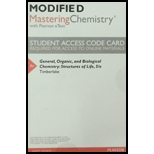
Concept explainers
(a)
Interpretation:
To comprehend the amino acid present in the given structure of dipeptide.
Concept Introduction:
Amino acids are organic molecules with -NH2 and −COOH groups bonded on same carbon atom. Here these two functional groups are involved in the formation of an amide linkage which is called as peptide linkage. Two amino acids combine to form one dipeptide molecule.
(b)
Interpretation:
The name of dipeptide in aspartame should be determined.
Concept Introduction:
Amino acids are organic molecules with -NH2 and −COOH groups bonded on same carbon atom. Here these two functional groups are involved in the formation of an amide linkage which is called as peptide linkage. Two amino acids combine to form one dipeptide molecule.
(c)
Interpretation:
The three letters and one letter abbreviation for the dipeptide in aspartame should be determined.
Concept Introduction:
Amino acids are organic molecules with -NH2 and −COOH groups bonded on same carbon atom. Here these two functional groups are involved in the formation of an amide linkage which is called as peptide linkage. Two amino acids combine to form one dipeptide molecule.
Want to see the full answer?
Check out a sample textbook solution
Chapter 18 Solutions
Modified MasteringChemistry with Pearson eText - Valuepack Access Card - for General, Organic, and Biological Chemistry: Structures of Life
 ChemistryChemistryISBN:9781305957404Author:Steven S. Zumdahl, Susan A. Zumdahl, Donald J. DeCostePublisher:Cengage Learning
ChemistryChemistryISBN:9781305957404Author:Steven S. Zumdahl, Susan A. Zumdahl, Donald J. DeCostePublisher:Cengage Learning ChemistryChemistryISBN:9781259911156Author:Raymond Chang Dr., Jason Overby ProfessorPublisher:McGraw-Hill Education
ChemistryChemistryISBN:9781259911156Author:Raymond Chang Dr., Jason Overby ProfessorPublisher:McGraw-Hill Education Principles of Instrumental AnalysisChemistryISBN:9781305577213Author:Douglas A. Skoog, F. James Holler, Stanley R. CrouchPublisher:Cengage Learning
Principles of Instrumental AnalysisChemistryISBN:9781305577213Author:Douglas A. Skoog, F. James Holler, Stanley R. CrouchPublisher:Cengage Learning Organic ChemistryChemistryISBN:9780078021558Author:Janice Gorzynski Smith Dr.Publisher:McGraw-Hill Education
Organic ChemistryChemistryISBN:9780078021558Author:Janice Gorzynski Smith Dr.Publisher:McGraw-Hill Education Chemistry: Principles and ReactionsChemistryISBN:9781305079373Author:William L. Masterton, Cecile N. HurleyPublisher:Cengage Learning
Chemistry: Principles and ReactionsChemistryISBN:9781305079373Author:William L. Masterton, Cecile N. HurleyPublisher:Cengage Learning Elementary Principles of Chemical Processes, Bind...ChemistryISBN:9781118431221Author:Richard M. Felder, Ronald W. Rousseau, Lisa G. BullardPublisher:WILEY
Elementary Principles of Chemical Processes, Bind...ChemistryISBN:9781118431221Author:Richard M. Felder, Ronald W. Rousseau, Lisa G. BullardPublisher:WILEY





